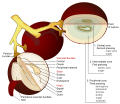Pressing (wine)
Pressing
Template:Wine navigation
This wine term related article is a stub.
Pressing is a crucial step in the winemaking process, specifically in the production of wine. It refers to the extraction of juice from the grapes, which is then used to create the base for fermentation. The pressing process plays a significant role in determining the quality and characteristics of the resulting wine.
Process
Pressing typically takes place after the grapes have been harvested and sorted. The grapes are carefully loaded into a wine press where pressure is applied to release the juice. The pressing can be done manually or using mechanical presses, depending on the scale of production.
White Wine Pressing
For the production of white wine, the grapes are usually pressed immediately after harvesting. The grapes are gently crushed to break the skins and release the juice. The juice is then separated from the solids, such as the grape skins, seeds, and stems, through a process called must clarification. This ensures that only the clear juice is used for fermentation.
Red Wine Pressing
In the case of red wine, the pressing process is slightly different. After the grapes are harvested, they are typically destemmed and crushed to release the juice along with the skins. This mixture, known as the must, is then fermented together. The skins provide color, tannins, and flavor compounds to the wine during fermentation. The pressing of red wine usually occurs after fermentation is complete, allowing for maximum extraction of these desirable components.
Pressing Techniques
Winemakers employ various pressing techniques to achieve different results. These techniques can influence the style, flavor profile, and quality of the wine produced.
Whole Cluster Pressing
Whole cluster pressing involves pressing the grapes with their stems intact. This technique is commonly used for the production of Champagne and other sparkling wines. The stems help to channel the juice flow and can contribute to the wine's structure and complexity.
Basket Pressing
Basket pressing is a traditional method where the grapes are placed in a basket or cage, and pressure is applied to extract the juice. This technique is often favored for small-scale production or premium wines, as it allows for gentle extraction and control over the pressing process.
Pneumatic Pressing
Pneumatic pressing involves the use of a pneumatic press, which applies pressure to the grapes in a controlled manner. This technique allows winemakers to adjust the pressure and duration of pressing, resulting in precise extraction and control over the juice quality.
Importance of Pressing
The pressing stage significantly impacts the final characteristics of the wine. It determines the amount of tannins, color, and flavor compounds extracted from the grape skins. The duration and pressure applied during pressing also influence the overall quality and style of the wine.
References
Transform your life with W8MD's budget GLP-1 injections from $125.
W8MD offers a medical weight loss program to lose weight in Philadelphia. Our physician-supervised medical weight loss provides:
- Most insurances accepted or discounted self-pay rates. We will obtain insurance prior authorizations if needed.
- Generic GLP1 weight loss injections from $125 for the starting dose.
- Also offer prescription weight loss medications including Phentermine, Qsymia, Diethylpropion, Contrave etc.
NYC weight loss doctor appointments
Start your NYC weight loss journey today at our NYC medical weight loss and Philadelphia medical weight loss clinics.
- Call 718-946-5500 to lose weight in NYC or for medical weight loss in Philadelphia 215-676-2334.
- Tags:NYC medical weight loss, Philadelphia lose weight Zepbound NYC, Budget GLP1 weight loss injections, Wegovy Philadelphia, Wegovy NYC, Philadelphia medical weight loss, Brookly weight loss and Wegovy NYC
|
WikiMD's Wellness Encyclopedia |
| Let Food Be Thy Medicine Medicine Thy Food - Hippocrates |
Medical Disclaimer: WikiMD is not a substitute for professional medical advice. The information on WikiMD is provided as an information resource only, may be incorrect, outdated or misleading, and is not to be used or relied on for any diagnostic or treatment purposes. Please consult your health care provider before making any healthcare decisions or for guidance about a specific medical condition. WikiMD expressly disclaims responsibility, and shall have no liability, for any damages, loss, injury, or liability whatsoever suffered as a result of your reliance on the information contained in this site. By visiting this site you agree to the foregoing terms and conditions, which may from time to time be changed or supplemented by WikiMD. If you do not agree to the foregoing terms and conditions, you should not enter or use this site. See full disclaimer.
Credits:Most images are courtesy of Wikimedia commons, and templates, categories Wikipedia, licensed under CC BY SA or similar.
Contributors: Prab R. Tumpati, MD










